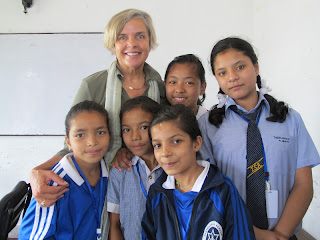 |
| The Pashupati Temple |
 |
| The final act of making an offering of rice, seeds and an oil lamp to the river |
A few days ago I spent a fascinating afternoon just observing at Pashupati temple and cremation site. This is one of the most important Hindu sites in Nepal where the god Shiva reigns supreme. It is also the site where Hindus are cremated.
Far from being gruesome, the site is awe inspiring to me. It is a powerful place to contemplate life and death. For Hindus, death is a step towards the next incarnation. A spirit continues to be reborn.
Open air cremations happen all day, every day here. The bodies are
brought to the Bagmati river on a metal
stretcher and are covered in layers of saffron cloth. They are then placed on a stone slab which slopes down towards the river.
This slab is near the square stone ghat where the cremation fire is built. Once on the slab various ritual body washings occur using the black water of the Bagmati.
I sat on the stone steps by the filthy, but holy, Bagmati river across the cremation ghats and just watched and tried to figure out what in the world was happening. Bells rang, tinny horns called, cleaning women swept the steps and the crackle of fires were the only sounds. Mourners grieved mostly silently and visitors were solemn. A monkey stared at us all while the holy men (sadhus) rested in the shade.
Across the narrow river I watched a young man bend near a saffron covered body and then place incense sticks in the four holes of the slab on which the body lay. The smoke of the incense mixed with the smoke of the candles at the body's head. Various other mourners brought more saffron cloth pieces and gently placed them over the body. Others rested golden marigold garlands on the chest.
Enterprising little boys scrambled in the dark river water searching for metal....in fact, one fellow fished with a magnet looking for coins. Serious miners hope to retrieve gold fillings from the water.
I noticed that once a receipt was returned to a mourner, then work started to build the fire. (I was told that it costs about $25 to be cremated at Pashupati.)
First a mix of green and dry grass is scattered to cover the funeral slab. Then three neat piles of rice are placed in the middle of the slab and finally the pieces of firewood are perfectly stacked. Before the body was carried to rest on the wood, the head was revealed and washed by a few family members who poured drops of river water from a brass urn .
Then the body was carried to the waiting pyre while the family scattered vermillion powder, rice and marigold blossoms on the body. The pall bearers were men wearing white shirts who carried the body around the unlit pyre three times. At that point, the body was piled with saffron robes, a few white Buddhist neck scarves (katas) as well as the red powder, rice and flowers. It was placed on the stack of wood and then a male family member wearing a white robe walked around the pyre three times. The eldest son or grandson or other male family member is obliged to light the fire for a male.
This young man lit a wick to start the fire at the base of the head. As soon as the fire was burning and a few saffron cloths were tossed in the water by the fire tenders, the ragamuffins were in the water searching for coins. There were no other sounds but for some quiet crying.
I was told that it takes 3-4 hours for a body to burn completely. So family members sit under a covered porch and wait. Once the body has burnt, the male relatives must use the river water to wash the ghat clean making sure that all the ashes are in the river. Once the ashes are all in the water and the ghat is clean and ready for the next cremation, a male family member walks to the middle of the shallow river.
I watched a man as h
e carried a basket with rice, seeds and an oil lamp which he placed in the middle of the river after ducking his head in the water. The basket quickly sank, but the rice and lamp floated as one down the river.
 |
| One of many monkeys who live by the river |
 |
| These flowers are for sale as we walk to the temple area. |
 |
| The long row of cremation ghats |
 |
| Hindu holy men watching a service |
 |
| These sadhus wait in the shade and hope to be paid for having their photo taken. |
 |
| Grief |
 |
| Layers of saffron cloths are placed on the body |
 |
| A monkey sits in the river among the marigolds, logs, straw and ashes. |
Though terribly sad for the loved ones of the deceased, there was a feeling of respect and camaraderie among the visitors at Pashupati. Grief is grief anywhere. Though we didn't all speak the same language or share the same religion, we shared the knowledge that we will all die. I want to believe that the ritual and tradition must offer some comfort to the mourners of Pashupati.


















































